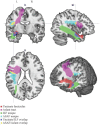Regional white matter damage predicts speech fluency in chronic post-stroke aphasia
- PMID: 25368572
- PMCID: PMC4201347
- DOI: 10.3389/fnhum.2014.00845
Regional white matter damage predicts speech fluency in chronic post-stroke aphasia
Abstract
RECENTLY, TWO DIFFERENT WHITE MATTER REGIONS THAT SUPPORT SPEECH FLUENCY HAVE BEEN IDENTIFIED: the aslant tract and the anterior segment of the arcuate fasciculus (ASAF). The role of the ASAF was demonstrated in patients with post-stroke aphasia, while the role of the aslant tract shown in primary progressive aphasia. Regional white matter integrity appears to be crucial for speech production; however, the degree that each region exerts an independent influence on speech fluency is unclear. Furthermore, it is not yet defined if damage to both white matter regions influences speech in the context of the same neural mechanism (stroke-induced aphasia). This study assessed the relationship between speech fluency and quantitative integrity of the aslant region and the ASAF. It also explored the relationship between speech fluency and other white matter regions underlying classic cortical language areas such as the uncinate fasciculus and the inferior longitudinal fasciculus (ILF). Damage to these regions, except the ILF, was associated with speech fluency, suggesting synergistic association of these regions with speech fluency in post-stroke aphasia. These observations support the theory that speech fluency requires the complex, orchestrated activity between a network of pre-motor, secondary, and tertiary associative cortices, supported in turn by regional white matter integrity.
Keywords: aphasia; arcuate fasciculus; frontal aslant tract; inferior longitudinal fasciculus; non-fluent speech; speech production; uncinate fasciculus.
Figures



References
-
- Albert M., Goodglass H., Helm N. A., Rubens A., Alexander M. (1981). Clinical Aspects of Dysphasia. New York, NY: Springer-Verlag
Grants and funding
LinkOut - more resources
Full Text Sources
Other Literature Sources

